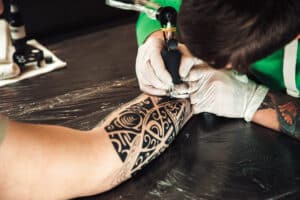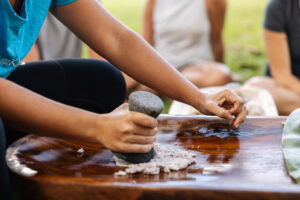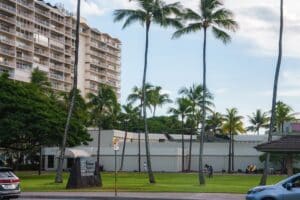This article was originally published on April 22, 2022, and was updated Oct. 7, 2025.
If it’s your first time visiting the islands, you may find the language a little confusing. Words like “shoots,” “slippahs” and “da kine” probably aren’t part of your everyday vocabulary. That’s why we created this guide to help you out.
What is Hawaiʻi Pidgin?
Hawaiʻi Pidgin, often just called “Pidgin,” is an English-based creole language spoken in Hawaiʻi. It blends words and grammar from English, Hawaiian, Japanese, Portuguese, Chinese, Filipino and other immigrant languages, developed during the plantation era in the late 1800s and early 1900s.
Originally used as a way for plantation workers from different cultures to communicate, Pidgin has evolved into a unique, expressive local language that reflects Hawaiʻi’s multicultural identity.
Is Hawaiʻi Pidgin an actual language?
Yes, Hawaiʻi Pidgin is a real language — technically classified as a creole language by linguists. It has its own grammar, vocabulary and pronunciation patterns, and many people in Hawaiʻi speak it as their first language.
Though often misunderstood as “broken English,” Pidgin is not slang or incorrect speech — it’s a rule-based language in its own right, recognized by institutions like the U.S. Census Bureau and studied in academic settings.
Who speaks Pidgin in Hawaiʻi?
Pidgin is spoken by many locals across Hawaiʻi. It’s commonly used among friends, family and in casual or familiar situations.
While it originated among working-class communities, today it’s spoken by people from all backgrounds and generations — from school kids to kūpuna (elders). Some people grow up bilingual, switching between Pidgin and Standard English depending on the setting.
How do you understand Pidgin?
To understand Hawaiʻi Pidgin, it helps to:
-
Listen to locals — watch local YouTube channels, TikToks, or shows like “Pidgin 101.”
-
Learn common words and expressions — See our list below.
-
Get used to the rhythm and flow — Pidgin has its own pace and pronunciation.
-
Be respectful and curious — understanding the cultural context is just as important as the words.
Tip: Reading or watching Pidgin content with subtitles can help you learn quickly.
What’s the difference between Hawaiian and Pidgin?
Hawaiian (ʻŌlelo Hawaiʻi) and Pidgin (Hawaiʻi Creole English) are two very different languages:
| Feature | Hawaiian Language (ʻŌlelo Hawaiʻi) | Hawaiʻi Pidgin |
|---|---|---|
| Language Family | Polynesian (Austronesian) | English-based Creole |
| Origin | Indigenous language of Hawaiʻi | Developed in the 1800s during plantation era |
| Vocabulary | Mostly Hawaiian | Mix of English, Hawaiian, Asian & European languages |
| Status | One of Hawaiʻi’s two official languages | Spoken widely, informal, not official |
| Written Form | Yes, standardized grammar and alphabet | Mostly oral, but written Pidgin exists |
In short:
-
Hawaiian is the native language of the Hawaiian people, deeply tied to culture, history, and identity.
-
Pidgin is a local creole born from the blending of cultures in modern Hawaiʻi, used in everyday life by many residents.
To help you navigate without missing anything in translation, we’ve put together a collection of commonly used words and phrases in Hawai‘i Creole English — still widely referred to as Pidgin today — that you should know.
1. Aloha
Aloha can mean hello and goodbye, but it is also the spirit of generosity, love, respect and reciprocity people in Hawaiʻi encompass, hence the term “aloha spirit.”
“Aloha!”
2. ʻĀina
The Hawaiian word for land, locals will often refer to the island youʻre on as the “ʻāina.”
“Please pick up your trash to care for our ʻāina.”
3. Aurite
A local way of saying “alright,” residents of Hawaiʻi use aurite as a more excited way of agreeing with something or for confirmation.
“Keoni got some poke? Aurite!”
4. Aunty/Unko
It’s not uncommon for kamaʻāina to call men and women older than them “aunty” or “unko”—a local version of uncle that omits the “le” sound. You donʻt have to be blood related at all to be—or call someone—an aunty or unko.
“Hey aunty how are you doing? Is unko Silva still working at Pearl Harbor?”
5. Bumbai
Pidgin phrase that typically means “later.”
“You better pick up your slippahs bumbai you’ll get scolded.”
6. Braddah (Brah)
An endearing way to call a peer.
“Hey brah, you left your wallet at 7-11!”
7. Broke da Mouth
When something you’ve eaten is so good, that your mouth is left in a state of disbelief and can be considered “broken.”
“Aunty Thelma’s banana lumpia was so good brah, broke da mouth.”
8. Chee-hoo
An extremely local expression of excitement or happiness. The longer you can draw out the “chee” and “hoo” phase of the word, the better.
“Rebel Souljahz set was so good! Chee-hoo!”
9. Choke
Plenty, or a lot.
“I went to Costco last Sunday and had choke cars in the parking lot.”
10. Coconut Wireless
Local word-of-mouth is strong, especially in smaller communities. It’s so strong we’ve begun calling it the “coconut wireless.”
“I heard on the coconut wireless that Sabrina just got engage to Rubio. For real, my aunty heard it from her daughter’s best friend’s boyfriend!”
11. Da Kine
A catch-all term to denote literally anything you can’t remember the name of.
“Shoot, you remember where I put da kine? It was right by da kine when I left for da kine.”
12. E Komo Mai
Welcome.
“I heard you just moved here. E komo mai!”
13. Fut
To fart.
“Tati did you just fut? Brah it stinks so bad.”
14. Green Bottles
Specifically used to refer to Heinekens, the preferred beer of quite a few locals in Hawaiʻi.
“We gonna hit the beach this Thursday—Sandy’s of course—with a six pack of green bottles if you wanna come?”
15. Grinds (Grindz)
To eat, it can also refer to food. It can also be spelled with a “z” for unknown reasons.
“I surfed so long yesterday, I was grinding on some ono grindz.”
16. Hale
Home, someone’s house.
“Come over to my hale for some grinds.”
17. Hamajang
When someone or something is very sloppy or haphazardly.
“Did you see Jaden’s room? So hamajang!”
18. Hana Hou!
A term used to ask for “one more!” Typically will be shouted by a crowd of a music act to encourage the artist to perform an encore.
“Hana hou, hana hou, hana hou!”
19. Hanabata Days
Childhood, when you were a child.
“I loved those red Otter Pops from my hanabata days.”
20. Hapa
Half, usually used to denote that someone is of two ethnicities.
“Didn’t you know Dillyn is hapa? She’s Japanese and Caucasian.”
21. Hawaiian Time
If you’re running late, or just aren’t in a rush to get to something or do something, you’re on Hawaiian time.
“Sorry Kainoa, I’m gonna be a bit late to dinner, I’m on Hawaiian time right now.”
22. Ho
If you’re trying to get someone’s attention, a short “ho” will do the trick.
“Ho! You got the time?”
23. Holo Holo
To venture out, cruise around or “head out.”
“I just went holo holo around Kaimukī and found the coolest little coffee shop.”
24. Howzit
A combination of the words “how” “is” and “it.” Often used to ask someone how it’s going, or how they are doing.
“Ho howzit brah?”
25. Irrahz
If you’re annoyed, or someone is annoyed, they are irrahz.
“I went to the Wahiawa DMV to get my license renewed and the line was so long, brah I was so irrahz.”
26. Junk
A way to describe that something is bad or not up to par.
“Not going to lie, that movie was pretty junk.”
27. Kamaʻāina
Longtime resident or local.
“My great-grandparents came over to Hawaiʻi during the plantation days and our family has been here ever since, so yeah I guess we’re kamaʻāina.”
28. Kanaks (Kanak Attack)
Being put into a food coma.
“I fully had a kanak attack after pounding down that chili loco moco from Zippy’s.”
29. Kapu
A term of warning that something is forbidden or not allowed.
“Kapu, do not enter.”
30. Kāne
Man, men.
“Don’t go into the bathroom marked wahine, Richard. You want the one that says kāne.”
31. Keiki
Kid, children.
“It was so cute watching all the keiki run around Makiki District Park yesterday for their soccer games.”
32. Kuleana
The Hawaiian word for privilege, responsibility or to take responsibility.
“The beach is our kuleana, and we have to make sure to pick up our trash and the trash of others to keep it clean.”
33. L’dat
A combination of the words “like” and “that.”
“I like it just l’dat.”
34. Lānai
Not to be confuse with Lānaʻi, the island, lānai mean porch,or veranda.
“Let’s go cruise on my lānai and watch the sunset.”
35. Local
Like a kamaʻāina, someone who has lived in Hawaiʻi since birth or for a long—long—time. People who live in Hawaiʻi are referred to as locals, and not Hawaiians—unless they are of Hawaiian descent.
“I never knew Chris was a local until he busted out in the meanest Pidgin.”
36. Mahalo
A way to say thanks, or thank you.
“Mahalo for the malasadas!”
37. Makai
Towards the ocean. Often used in a directional sense.
“The theater is makai of Whole Foods on Kamake’e Street.”
38. Mauka
Inland, or towards the mountains. Often used in a directional sense.
“Where are you at Ala Moana? Are you at the mauka side bus stop?”
39. Nah nah nah
Just joking.
40. ʻOhana
Family.
“ʻOhana means family, and family means nobody gets left behind.
41. ʻŌkole
Word for butt.
“Seriously pick up your slippahs bumbai you gonna get your ʻōkole whipped!”
42. ʻOno
When food is delicious, it’s ʻono.
“My unko Braden made the best steaks last night, was so ʻono.”
43. ʻŌpala
Garbage, trash.
“Make sure to bring a bag with you on any hike you go on so you can pick up ʻōpala.”
44. Pau Hana
To be done with work, often used to denote happy hour at bars.
“Let’s go hit up the pau hana special at Duke’s and start the weekend off right.”
45. Poke
Cubed raw fish that can be eaten on its own or in a bowl of rice, called a poke bowl.
“Foodland Pūpūkea has the best poke bowl on island, seriously.”
46. Pūpū
Appetizer or appetizers.
“Let’s share a pūpū, I don’t want to fill up to much before the main.”
47. Rajah Dat
Local way of saying “rodger that.”
“You want to go hike Koko Head Crater tomorrow morning? Rajah dat!”
48. Shoots
To agree with something, or to say goodbye.
“Jadelynn needs to use my car? Shoots!”
49. Slipphas
Flip flops, sandals.
“Brah who took my slippahs. For real, who took them.”
50. Small Kine
A small amount of something or having a small resemblance to something else.
“I was small kine annoyed that Tiffany stood me up last night, but it was all good, her pit bull got out and she had to find him.”
51. Talk Story
To talk about anything and everything—it can range from small talk with strangers to catching up with old high school friends.
“I saw Kyle from my class in Roosevelt and we talked story for half-an-hour.”
52. Tanks
Local pronunciation of “thanks.”
“Ho, tanks!”















